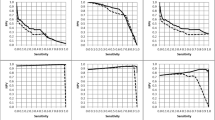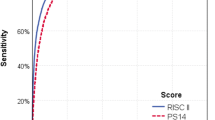Summary
When comparing two populations of multiply injured patients differences in patient characteristics must be controlled for. To measure the overall severity of injury, scaling systems are used. If after adjustment for injury severity, the proportion of deaths in the two data sets are still different, the difference is to be considered as due to the quality of care. However, this conclusion is only valid after excluding the possibility that the scale in use fails to adequately reflect certain injuries. The scope of the study is to demonstrate a method for examining this potential interference. As an example, four widely used scales were applied to the data of 418 multiply injured patients. By means of multiple logistic regression analysis, variables were selected which have an influence on prognosis in addition to a scale, thus indicating a subgroup of patients who are underrepresented by the respective scoring system. For the scales examined, these additional variables were: Head and thoracic trauma for the Polytrauma score (Oestern), abdominal and thoracic trauma for the Trauma index (Schreinlechner), thoracic trauma and age for the Trauma score (Champion), head trauma and age for the Injury Severity Score (Baker). We conclude that each score analyzed had its characteristic weak points. Prognostic quality was affected by casemix. Therefore, comparisons between groups of polytraumatized patients may be invalidated. The method outlined here is a useful means for checking a scoring system for these types of interfering variables. Therefore, it is recommended to search routinely for potentially interfering variables before applying a scale. In a given data set of multiply injured patients, appropriate adjustments can then be made for the deficiencies of the scoring system.
Zusammenfassung
Polytraumascores dienen unter anderem dazu, den Einfluß des Verletzungsmusters auf die Letalität zu kontrollieren. Unterschiede in der Letalität zweier Kollektive sind, nach Berücksichtigung der Verletzungsschwere, nur dann auf Behandlungsunterschiede zurückzuführen, wenn auszuschließen ist, daß der verwendete Polytraumascore bestimmte Verletzungen unzureichend erfaßt. In dieser Studie wird gezeigt, wie diese Bedingung überprüft werden kann. Als Rechenbeispiel wurden dazu 4 Polytraumascores anhand der Daten von 418 Polytraumapatienten untersucht. Mittels multipler logistischer Regressionsrechnung wurden Einfluß- bzw. Störfaktoren identifiziert, die zusätzlich zu dem jeweiligen Polytraumascore zur Prognose der Letalität beitrugen. Sie wiesen auf Diagnosegruppen hin, die durch den Score ungenügend erfaßt waren. Die Schwachstellen der Polytraumascores waren unterschiedlich. Die in dieser Studie gefundenen Störfaktoren waren für den Polytraumaschlüssel (Oestern) das Schädel-Hirn-Trauma (SHT) und das Thoraxtrauma, für den Traumaindex (Schreinlechner) das Abdominal- und Thoraxtrauma, für den Traumascore (Champion) das Thoraxtrauma und das Alter, für den „Injury Severity Score“ (Baker) das SHT und das Alter. Die 4 untersuchten Polytraumascores erfüllten daher im untersuchten Kollektiv die Anforderung der Unabhängigkeit vom Verletzungsmuster nicht. Vergleiche können daher verfälscht werden. Wie am Beispiel der 4 untersuchten Scores demonstriert, eignet sich die Methode für die Aufgabe, einen Polytraumascore in einem gegebenen Kollektiv auf diesen Typ von Störanfälligkeit zu untersuchen. Es folgt daraus die Empfehlung, routinemäßig vor Verwendung eines Scores mögliche Einfluß- und Störgrößen zu suchen. Dadurch kann eine der jeweils vorliegenden Aufgabenstellung entsprechende Korrektur vorgenommen werden.
Similar content being viewed by others
Author information
Authors and Affiliations
Rights and permissions
About this article
Cite this article
Foltin, E., Stockinger, A. The predictive qualities of four widely used scaling systems for multiply injured patients are not independent of the injury pattern. A method for identifying interfering variables is demonstrated. Unfallchirurg 102, 98–109 (1999). https://doi.org/10.1007/s001130050380
Published:
Issue Date:
DOI: https://doi.org/10.1007/s001130050380




